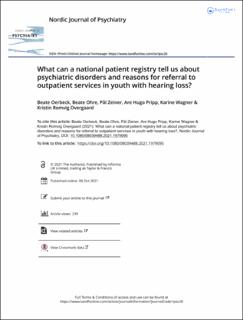| dc.contributor.author | Ørbeck, Beate | |
| dc.contributor.author | Øhre, Beate | |
| dc.contributor.author | Zeiner, Pål | |
| dc.contributor.author | Pripp, Are Hugo | |
| dc.contributor.author | Wagner, Karine | |
| dc.contributor.author | Øvergaard, Kristin Romvig | |
| dc.date.accessioned | 2022-02-18T13:54:31Z | |
| dc.date.available | 2022-02-18T13:54:31Z | |
| dc.date.created | 2021-12-10T19:17:44Z | |
| dc.date.issued | 2021-10-06 | |
| dc.identifier.issn | 0803-9488 | |
| dc.identifier.issn | 1502-4725 | |
| dc.identifier.uri | https://hdl.handle.net/11250/2980093 | |
| dc.description.abstract | Background: Studies of reasons for referral to the Child and Adolescent Mental Health Services (CAMHS) and subsequent psychiatric disorders are missing in youth with Hearing loss (HL).
Aims: To examine the referral reasons to CAMHS and the clinically diagnosed psychiatric disorders in youth with HL among the nationally representative population.
Methods: The study population was a youth with HL referred to CAMHS and registered in the national Norwegian Patient Registry (NPR) during the years 2011–2016. The results were also compared with some data published from CAMHS for the General Youth Population (GenPop).
Results: Among youth with HL, 18.1% had also been referred to CAMHS compared to about 5% in GenPop, at mean age 9.1 years, >70% before age 13 years vs. 46% in the GenPop. Boys with HL comprised 57% and were referred about two years earlier than girls with HL. Compared to the GenPop, youth with HL were referred more frequently for suspected neurodevelopmental- and disruptive disorders, and less frequently for suspected emotional disorders. Girls with HL were referred for suspected Attention-Deficit/Hyperactivity Disorder (ADHD) at about the same rate as boys with HL in the 7–12 year age group. The most frequently registered psychiatric disorders were ADHD: 29.8%, anxiety disorders: 20.4%, and autism spectrum disorders: 11.0%, while disruptive disorders constituted about 5.0%.
Conclusions: Youth with HL were referred to CAMHS more often, but earlier than the GenPop, mostly due to ADHD disorders. Although more rarely referred for suspected anxiety disorders, these were frequently diagnosed, suggesting that anxiety was not recognized at referral in youth with HL | en_US |
| dc.language.iso | eng | en_US |
| dc.publisher | Routledge | en_US |
| dc.relation.ispartofseries | Nordic Journal of Psychiatry; | |
| dc.rights | Attribution-NonCommercial-NoDerivatives 4.0 Internasjonal | * |
| dc.rights.uri | http://creativecommons.org/licenses/by-nc-nd/4.0/deed.no | * |
| dc.subject | Deafness | en_US |
| dc.subject | International disease classifications | en_US |
| dc.subject | National patient registries | en_US |
| dc.subject | Psychiatry | en_US |
| dc.subject | Referral symptoms | en_US |
| dc.title | What can a national patient registry tell us about psychiatric disorders and reasons for referral to outpatient services in youth with hearing loss? | en_US |
| dc.type | Peer reviewed | en_US |
| dc.type | Journal article | en_US |
| dc.description.version | publishedVersion | en_US |
| dc.rights.holder | © 2021 The Author(s) | en_US |
| cristin.ispublished | true | |
| cristin.fulltext | original | |
| cristin.qualitycode | 1 | |
| dc.identifier.doi | https://doi.org/10.1080/08039488.2021.1979095 | |
| dc.identifier.cristin | 1967283 | |
| dc.source.journal | Nordic Journal of Psychiatry | en_US |
| dc.source.pagenumber | 1-7 | en_US |

